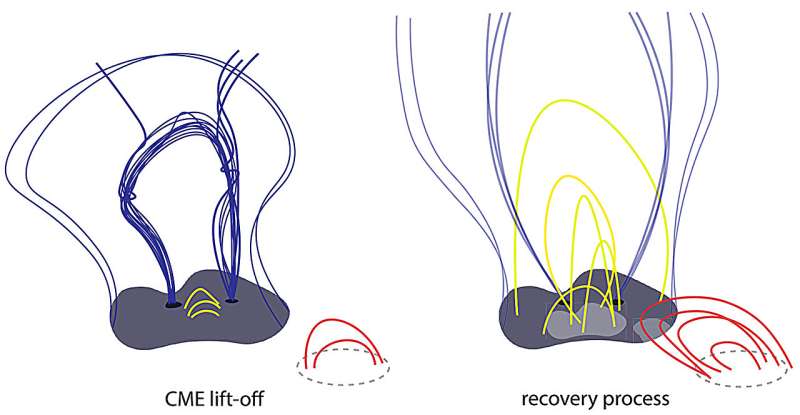
A research team has presented a mechanism that explains how coronal dimmings—darkened, depleted areas on the sun caused by intense plasma eruptions—recover.
This study offers valuable insights into how the solar corona replenishes after a coronal mass ejection (CME), advancing our understanding of the processes that drive extreme space weather events. With the current solar cycle nearing its peak, these events are becoming more frequent. The study’s findings are published in Astronomy & Astrophysics, and the team includes researchers from Skolkovo Institute of Science and Technology, Politecnico di Milano, NorthWest Research Associates, the University of Graz, and the Kanzelhöhe Observatory.
Coronal mass ejections are giant, billion-ton bubbles of magnetic plasma that burst outward from the sun, reaching Earth in just a few days and triggering intense geomagnetic storms that disrupt the technology we rely on daily and, ultimately, impact our lives.
As recently as May 2024, an extreme storm forced transpolar flights to be rerouted, and spacecraft had to perform more than 5,000 maneuvers to stay in orbit. The challenge is that detecting a coronal mass ejection in its early stages is difficult; typically, these events are only spotted once they are well-developed and visible to coronagraphs that simulate a total solar eclipse.
However, we can track signs of these eruptions on the sun by observing coronal dimmings—dark regions that appear in extreme ultraviolet (EUV) images of the solar corona that indicate a loss of material during a plasma ejection and offer insights into its mass, speed, and direction.
The team developed methods to analyze the lifetime of coronal dimmings, revealing how and when the solar corona recovers and replenishes after a CME, using long-term, multi-viewpoint observations of coronal dimmings over several days from the onset of the CME.
“Thanks to high-resolution images from the SDO and STEREO spacecraft, we’re now seeing coronal loops expand and brighten over dimming regions after CME eruptions. These loops, which appear both before and after eruptions, steadily cover and refill the dimmed areas, revealing the mechanism behind the sun’s recovery process,” says Giulia Ronca, a study lead author and graduate student of the Politecnico di Milano, who came to Skoltech under the Erasmus exchange program.
“We shouldn’t study the signatures of solar active events in isolation,” says Galina Chikunova, study co-author and Skoltech Ph.D. alumna, now continuing her research at the Hvar Observatory of the University of Zagreb.
“By extracting as much information as possible from solar images captured by various satellites, we can uncover unexpected relationships. We’ve observed that dimmings, the traces of solar explosions, often fade more quickly than expected.
Discover the latest in science, tech, and space with over 100,000 subscribers who rely on Phys.org for daily insights.
Sign up for our free newsletter and get updates on breakthroughs,
innovations, and research that matter—daily or weekly.
“By examining both the darkened and brightened areas of the corona, we’ve uncovered the ongoing progression of coronal loops—an essential recovery mechanism that helps explain why dimming disappears sooner than anticipated.”
“Coronal loops emerge in solar active regions, constantly forming and dissipating as they expand into the upper layers of the solar corona. While these loops are less bright than the surrounding structures, and are therefore challenging to detect, their expansion plays a key role in speeding up dimming recovery,” added Skoltech Associate Professor Tatiana Podladchikova, a co-author of the study.
This study sheds new light on eruptive solar phenomena, offering valuable perspectives on the processes that govern the sun’s behavior and its stormy mood.
More information:
G. M. Ronca et al, Recovery of coronal dimmings, Astronomy & Astrophysics (2024). DOI: 10.1051/0004-6361/202347934
Provided by
Skolkovo Institute of Science and Technology
How the sun heals after plasma eruption: New findings on coronal dimmings (2024, November 21)
retrieved 21 November 2024
from https://phys.org/news/2024-11-sun-plasma-eruption-coronal-dimmings.html
part may be reproduced without the written permission. The content is provided for information purposes only.